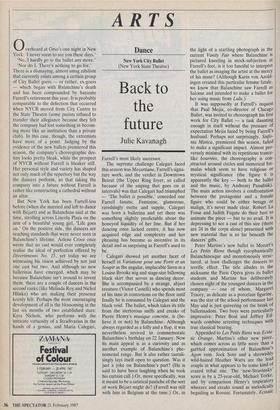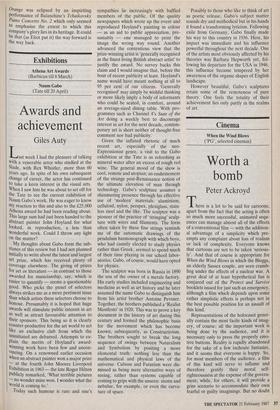ARTS
Dance
New York City Ballet (New York State Theatre) Back to
the future
Julie Kavanagh
0 verheard at Orso's one night in New York: 'I never seem to see you these days.'
'No, I hardly go to the ballet any more.'
`Nor do I. There's nothing to go for.' There is a dismaying, almost smug nihilism that currently exists among a certain group of City Ballet goers — or rather, ex-goers -- which began with Balanchine's death and has been compounded by Suzanne Farrell's retirement this year. It is probably comparable to the defection that occurred when NYCB moved from City Centre to the State Theatre (some purists refused to transfer their allegiance because they felt the company had lost something in becom- ing more like an institution than a private club). In this case, though, the extremists have more of a point. Judging by the evidence of the new ballets premiered this season, the company's choreographic des- tiny looks pretty bleak, while the prospect of NYCB without Farrell is bleaker still. Her personal style and variety has shaped not only much of the repertory but the way the dancers perform, so that taking the company into a future without Farrell is rather like constructing a cathedral without an altar.
But New York has been Farrell-less before (when she married and left to dance with Bejart) and as Balanchine said at the time, strolling across Lincoln Plaza on the arm of a beautiful young girl, 'Life goes on.' On the positive side, the dancers are reaching standards that were never seen in Balanchine's lifetime. Arlene Croce once wrote that no cast would ever completely realise the ideal of perfection offered by Divertimento No. 15, yet today we are witnessing his vision achieved by not just one cast but two. And although no new ballerinas have emerged, which may be because Balanchine isn't around to invent them, there are a couple of dancers in the second ranks (like Melinda Roy and Nichol Hlinka) who are making their presence keenly felt. Perhaps the most encouraging development of all is the blossoming in the last six months of two established stars: Kyra Nichols, who performs with the intricate virtuosity of a Stradivarius in the hands of a genius, and Maria Calegari, Farrell's most likely successor.
The supreme challenge Calegari faced this season was Mozartiana, Farrell's signa- ture work; and the verdict in Downtown Beirut (the Upper Ring foyer, so called because of the sniping that goes on at intervals) was that Calegari had triumphed — 'The ballet is possible,' conceded one Farrell fanatic. Feminine, glamorous, ravishingly svelte and supple, Calegari was born a ballerina and yet there was something slightly predictable about the honeyed liquidity of her line. But if her dancing once lacked centre, it has now acquired edge and complexity and her phrasing has become as inventive in its detail and as surprising as Farrell's used to be.
Calegari showed yet another facet of herself in Variations pour une Porte et un Soupir as the angular, implacable Siren in a Louise Brooks wig and stage-size billowing black skirt that serves as dancing decor. She is accompanied by a strange, abject creature (Victor Castelli) who spends most of his time in contortions on the floor until finally he is consumed by Calegari and the black void. The ballet, which takes its title from the stertorous sniffs and creaks of Pierre Henry's musique concrete, is (be- lieve it or not) by Balanchine. Although always regarded as a folly and a flop, it was nevertheless revived to commemorate Balanchine's birthday on 22 January. Now its main appeal is as a curiosity and as another example of Balanchine's phe- nomenal range. But it also rather tantali- singly lays itself open to question. Was it just a joke on Balanchine's part? (He is said to have been laughing when he took his curtain call.) Or, more specifically, was it meant to be a satirical pastiche of the sort of work Bej art might do? (Farrell was still with him in Belgium at the time:) Or, in the light of a startling photograph in the current Vanity Fair where Balanchine is pictured kneeling in mock-subjection at Farrell's feet, is it too fanciful to interpret the ballet as imaging the artist at the mercy of his muse? (Although Karin von Arold- ingen created this particular femme fatale, we know that Balanchine saw Farrell as Salome and intended to make a ballet for her using music from Lulu.) It was supposedly at Farrell's request that Paul Mejia, co-director of Chicago Ballet, was invited to choreograph his first work for City Ballet — a task daunting enough in itself without the pressure of expectation Mejia faced by being Farrell's husband. Perhaps not surprisingly, Sinfo- nia Mistica, premiered this season, failed to make a significant impact. Almost per- versely minimal with its repetitious trance- like bourrees, the choreography is con- structed around circles and numerical for- mulas which seem to have religious or mystical significance (the figure 6 is apparently the key — both to the ballet and the music, by Andrezej Panufnik). The main action involves a confrontation between the protagonist and a female figure who could be either benign or malign, it's never made clear. Robert La Fosse and Judith Fugate do their best to animate the piece — but to no avail. It is depressing to see a cast of this size (there are 24 in the corps alone) presented with new material that is so far beneath the dancers' gifts. Peter Martins's new ballet to Mozart's Les Petits Riens though sycophantically Balanchinesque and monotonously struc- tured, at least challenges the dancers to terrific effect. The title alludes to the nickname the Paris Opera gives its ballet students and MartinS has deliberately chosen eight of the youngest dancers in the company — one of whom, Margaret Tracey, as delicate as a porcelain figurine, was the star of the school performance last May and is just quivering on the brink of ballerinadom. Two boys were particularly impressive: Peter Boal and Jeffrey Ed- wards combine arresting techniques with true classical bearing.
Appended to Les Petits Riens was Ecsta- tic Orange, Martins's other new piece, which comes across as little more than a garbled approximation of Balanchine's Agon vein. Jock Soto and a shrewishly wild-haired Heather Watts are the lead couple in what appears to be some kind of crazed tribal rite. The 'new-Stravinsky' score is by a 25-year-old, Michael Torke, and by comparison Henry's respiratory wheezes and creaks sound as melodically beguiling as Rossini. Fortunately, Ecstatic Orange was eclipsed by an inspiriting performance of Balanchine's Tchaikovsky Piano Concerto No. 2 which only seemed to emphasise the extent to which this company's glory lies in its heritage. It could be that (as Eliot put it) the way forward is the way back.



















































 Previous page
Previous page